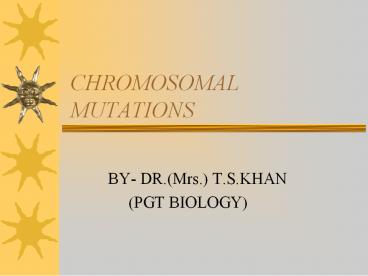CHROMOSOMAL MUTATIONS - PowerPoint PPT Presentation
1 / 23
Title:
CHROMOSOMAL MUTATIONS
Description:
CHROMOSOMAL MUTATIONS BY- DR.(Mrs.) T.S.KHAN (PGT BIOLOGY) Chromosomal Mutations Deletion part of the chromosome is missing Starts with breaks in the chromosome ... – PowerPoint PPT presentation
Number of Views:154
Avg rating:3.0/5.0
Title: CHROMOSOMAL MUTATIONS
1
CHROMOSOMAL MUTATIONS
- BY- DR.(Mrs.) T.S.KHAN
- (PGT BIOLOGY)
2
Chromosomal Mutations
- Deletion part of the chromosome is missing
- Starts with breaks in the chromosome
- Radiation, heat, viruses, chemicals, etc.
- May cause an unpaired loop
- May give rise to pseudodominance
- Cri-du-chat syndrome (Chrom. 5)
3
(No Transcript)
4
(No Transcript)
5
Chromosomal Mutations
- Duplication doubling of a segment of a
chromosome - Tandem
- Reverse tandem
- Terminal tandem
- Position Effect of barring eyes in Drosophila
6
(No Transcript)
7
(No Transcript)
8
Chromosomal Mutations
- Inversion results when a segment of a
chromosome is excised and then reintegrated in an
orientation 180 degrees from the original
orientation. - Pericentric inversion
- Paracentric inversion
- Resulting from a dicentric bridge
9
(No Transcript)
10
Chromosomal Mutations
- Translocation change in position of chromosome
segments and the gene sequences they contain to a
different location - Nonreciprocal intrachromosomal
- Nonreciprocal interchromaosomal
- Reciprocal interchromosomal
11
(No Transcript)
12
Chromosomal Mutations
- Fragile Sites and Fragile X Syndrome
- Narrowings or unstained areas (gaps)
- Recessive X-linked traits (predominately males)
- Normal transmitting males carrying a premutation
will have grandsons with mental retardations and
some granddaughters (up to 33) with mild
retardation
13
(No Transcript)
14
Variation in Chromosomal Number
- Euploidy the correct number of sets of
chromosomes in an organism - Monoploidy only one set of chromosomes when
there should be more - Male wasps, ants, and bees are monoploids because
they develop from unfertilized eggs - Used in plant-breeding experiments/colchicine
(inhibits mitotic spindle)
15
Variation in Chromosomal Number
- Polyploidy having three or more sets of
chromosomes - Usually occurs due to a breakdown of the mitotic
spindle - Usually occurs in plants (self-fertilization)
- Even numbered polyploids have a better chance of
being fertile than odd numbered polyploids - In humans, triploidy is usually lethal.
16
Variation in Chromosomal Number
- Polyploidy (continued)
- Autopolyploidy
- All sets of chromosomes originate in the same
species/defect in meiosis - Example a diploid gamete fuses with a haploid
gamete to produce a triploid zygote (bananas and
seedless fruit)
17
Variation in Chromosomal Number
- Polyploidy (continued)
- Allopolyploidy
- Sets of chromosomes originate from different
species though usually related - Because of differences between chromosomes, the
hybrid, no crossing over occurs and no viable
gametes produced making hybrids sterile - Occasionally, tow sets of different chromosomes
will double, producing tissues of 2N 2N2 /
produces fully fertile allotetraploid, 2N 2N2,
plants
18
(No Transcript)
19
Variation in Chromosomal Number
- Aneuploidy variation in the number of
chromosomes - Nullisomy - loss of one homologous chromosome
pair 2N 2 - Monosomy loss of a single chromosome
- 2N 1
- Trisomy single extra chromosome 2N 1
- Tetrasomy extra chromosome pair 2N 2
20
(No Transcript)
21
Variation in Chromosomal Number
- In humans, Down Syndrome is the only disorder
where an extra autosomal chromosome exists and
the individuals lives past three months. All
other embryos will self-abort or the infant will
die within 6 months. However, extra sex
chromosomes will not cause an embryo to
necessarily abort but the individual may have
other distinguishable characteristics.
22
Variation in Chromosomal Number
- Trisomy-21 Down Syndrome
- Trisomy-13 (Patau syndrome) cleft lip and
palate, small eyes, polydactyly and mental
retardation. Dies within 3 months - Trisomy-18 (Edwards syndrome) developmental
retardation, congenital malformations, and die
within 6 months
23
(No Transcript)

